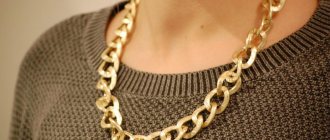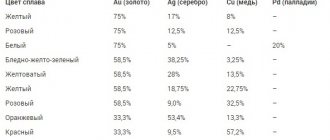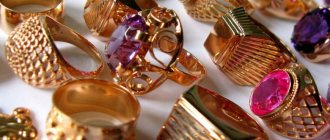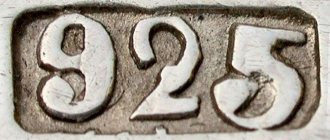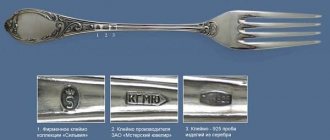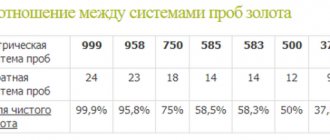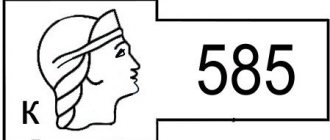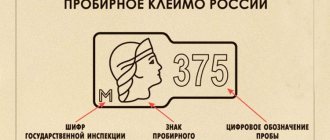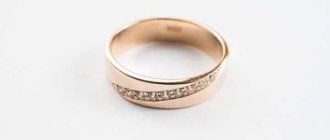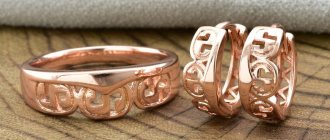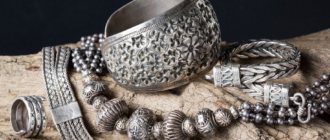Marking systems
All alloys that are used to make jewelry and other decorations contain a certain amount of yellow metal. So that the buyer has an idea of how much gold there actually is in the product, a system of special signs and designations has been developed . There are 4 known systems in total:
- carat;
- metric;
- spool;
- lot.
The last two have not been used for a long time; they are a thing of the past. The spool test was based on the value of the Russian pound, which was 96 spools. It was widespread until 1927, after which a transition was made to another system - the metric one. Lot designations were used mainly in Germany, but this country began to use metric samples even earlier.
The USA, Canada and most other Western countries prefer the karate system. According to accepted standards, a 24-carat precious metal is considered pure and without impurities. The remaining alloys, which are supplemented with other metals, are marked respectively at 9, 10, 14, 18 carats. For example, an 18-karat gold piece is made from 18 parts of the base yellow metal and 6 other components included in the alloy.
How much precious metal is in the product
Gold
– the metal is incredibly soft. In order for it to be possible to work with it, the stones are held firmly, and the gold ring on your hand does not turn into a shapeless mass after a year, a ligature is added to the alloy.
Most often it is copper, silver, nickel. Palladium, platinum and rhodium can be added to give gold a white color. And, although fewer products are produced from white gold, it occupies its share in the popular jewelry niche.
Today, 585 standard gold is used in products. This means that only 58.5% of the product contains actual gold. But there are also 370, 500, 750 and 958 samples.
The lower the sample number, the more the shade of the metal changes. For example, in the 370 sample there is as much as 67% copper alloy, and only 37% gold. This metal will have a red color. It is not popular in our country, so it is rarely used in work. It can be easily imported from countries in Middle Asia, including India.
Convert carats to grams
The karat measurement of metals should not be confused with the designation of precious stones. There the values change, for example, 513 carats corresponds to a stone weighing 102.6 grams, 583 carats - 116.6 grams, 686 carats - 137.2 grams.
The metric system determines the value of an alloy based on the gold content of 1 kg of the alloy. The most popular standard is 585, which means that per 1000 grams of alloy there are 585 grams of gold and 415 grams of impurities and other metals.
Since different countries have different systems, sometimes buyers get confused in determining the value of a product when choosing jewelry abroad. Gold hallmarks indicated in carats can be easily translated into understandable Russian numbers: 9 carats means a hallmark of 375 gold, 14 carats means 585, and 24 carats corresponds to the purest gold of 999 purity. For the manufacture of rings, 565 and 575 samples are most often used.
Stamps designate not only products made of gold, but also those made of silver and gilded. For example, a pure silver bar is 999 fine, but this composition is not suitable for making jewelry due to its softness and other physical properties. Household items correspond to hallmark 875, and jewelry - to 925. But gold rings, earrings and chains are not marked with hallmarks 593 and 725. Most likely, you got a fake, and you can determine this fact by contacting a pawnshop or buyers. They will evaluate the product.
Who chooses gold?
925 gold, unlike silver, does not exist. For many centuries, gold continues to be associated with wealth and power. Of course, this is the metal of merchants, conquerors and emperors. Jewelers note its flexibility in processing, brilliant color and durability.
It is in perfect harmony with all precious stones, and jewelry made from it serves people for many years. Just like 925 silver, gold has unique healing properties that are used for joint diseases and in homeopathy. Eastern doctors attributed to gold the positive energy “Yang” - the power of the sun, vigor, active movements and emotions.
Gold will give a feeling of strength to people with low blood pressure and depression. There is an assumption that young and energetic young people should not wear gold jewelry. But it is gold rings that are exchanged between young people when they get married.
Gold is given not only as a sign of long-term mutual love, but also with wishes of stability and prosperity, and to self-sufficient people - as recognition of their greatness and as a sign of respect. 975 gold is an excellent gift for people with skin color from golden beige to delicate peach, with light or greenish-brown eyes. This is metal for people of spring-autumn type of appearance. Gold jewelry is equally suitable for bright blondes, brunettes, redheads and fair-haired women.
Types and forms of brands
Precious jewelry is marked not only with gold hallmark numbers. All products must be branded. The applied mark may have a different shape, depending on the country of origin and the designation system adopted there. In Russia, two types of printing are most often found:
- image of a female profile facing the right side;
- a hammer and sickle located on a five-pointed star.
Regardless of the shape and type, the mark must contain mandatory information: the code of the service that applied the seal, the marking of the content of precious metal in the alloy used and the symbol of the assay service’s identification. The cost of products is directly proportional to the percentage of precious metal.
It is almost impossible for a simple buyer who has no experience working with jewelry to determine the authenticity of the applied mark. Often very good and high-quality fakes with 585 or even 750 purity are passed off as real gold. In fact, scammers have learned to illegally apply samples and deceive consumers. To check whether the value of the mark corresponds to the true content of the precious metal, a visual inspection with magnifying devices and additional testing procedures will be required.
The surface of the gold object is first cleaned, then passed over the surface of a special stone. There should be gold stripes left on it, onto which you need to apply reagents. If the sample is high, then the remaining strokes will not disappear and will not even change color. If the strips have completely dissolved, it means that the product is of low quality or does not contain yellow metal at all. At home, it is extremely difficult to determine the quality of products , and it is not even always clear whether it is gold or silver. The 325th standard is the lowest that is allowed in jewelry production; it may outwardly look like a gold-plated silver product.
325 gold items are in demand and highly valued in England and some other countries. In Russia, this metal is considered low-grade. Separately, we can highlight jewelry with the designation 588. They are made of a high-quality alloy, including 11 parts of yellow metal and 1 part of elite platinum. The cost of such goods is much higher. Elite items also include items marked 983; their price can be extremely high due to the use of noble red gold.
Price per gram of gold of different samples
Of course, the higher the content of noble metal in the alloy, the higher its price. The cost of materials of different samples depends on the current price of gold; the cost of finished products is also affected by the manufacturer’s and seller’s markups.
For example, today the Central Bank of the Russian Federation has set a price of 2,740 rubles for 1 gram of gold. To find out the cost of a precious alloy of different samples, you need to multiply this price by the appropriate coefficient:
- for sample 375: 2740*0.375=1027.5 rubles per 1 gram;
- for sample 585: 2740*0.585=1602.9 rubles per 1 gram.
The price of 1 gram of jewelry will be higher, because gold has a long way to go before it appears on the display in the form of a ring or bracelet. The cost of the finished product includes the work of jewelers, the cost of paying workers, losses on rejection, associated costs of the jewelry enterprise, and the store’s markup.
Application technologies
Modern jewelry manufacturers use one of three methods of applying stamps. Which technology will be used depends on various factors, the determining ones being the type of jewelry and the precious metal used. The most high-grade jewelry is very soft and fragile, so mechanical processing is not always suitable for them. The main methods of branding are:
- shock-mechanical;
- laser;
- electroerosive.
The mechanical impact method involves physical impact on the metal in order to obtain the desired impression. Stamps are applied with hammers or on special machines designed for mass production. Mechanical application was first used in the 17th century and remains the most popular technology in our time. Almost 85% of all manufactured gold products are branded using this method. The tags are durable and easily visible. Anvils of different shapes and sizes allow you to obtain the desired images with little risk of metal deformation.
Electroerosion technology involves burning out prints with a spark. The markings also appear clear and durable. This method is preferred when you need to apply meaning and image to particularly fragile jewelry. But when using electrical discharge machining, it is important that the surface is perfectly polished, without casting defects or the slightest roughness. The technology was first applied and mastered in 1967, so it is considered relatively young.
The laser method is an innovative branding method made possible by the development of high-precision laser equipment. It allows you to print minimally sized images that can be clearly read when using special magnifying devices. The laser can make up to 600 impressions in 1 work shift.
The surface of the product must be pre-polished and cleaned, because after branding it is impossible to grind and polish the metal. With the help of modern installations, it is possible to print even on hollow products, and the main advantage is the ability to place the image on both the concave and convex sides.
Application of this alloy
Jewelry for undemanding customers is made from the material described. 875 is stronger than 925, so it is harder to process. Rings, chains, bracelets, rings - this is the assortment of the 875th sample. Gemstone inlays are not uncommon for this material as it can hold them.
Also, the 875th sample is used to make tableware and candlesticks. No matter what year it is, silver tableware always remains a prestigious feature. Back in the late 19th and early 20th centuries, many houses and restaurants were furnished with silver sets.
But with the increasing costs of their production, as well as the need for constant cleaning, they were supplanted by their more practical counterparts. Cigarette cases, ashtrays, cup holders, and shot glasses are now common.
Extended Feature
Based on the brief data presented in the table, it is easy to conclude that a product of the highest quality and most expensive does not at all mean that it contains the greatest amount of pure metal.
To understand which silver sample is the best , you need to understand the characteristics of the samples and determine the purpose of using the material: jewelry, cutlery, dishes or other product.
Sample 999. Silver of the highest standard. It contains only 0.01% impurities, from which it is almost impossible to clean the metal. Pure silver is highly susceptible to deformation, so jewelry and other products are not made from it.
The scope of application of such material is very narrow. It is mainly used for the manufacture of solders and some parts of various types of devices. Also found in the form of ingots or souvenir collectibles.
Sample 960. High quality silver with a high content of pure metal. Rarely used in the jewelry industry due to its soft structure. This product is easy to scratch, so manufacturers cover it with enamel. The main advantage of the material is the ability to create highly artistic works from it. In addition to jewelry, silver of this standard is used in the production of decorative elements.
Sample 925 . The most common hallmark among jewelry. The relatively small amount of copper (7.5%) makes silver strong enough while remaining malleable to create a wide variety of shapes. Copper does not change the natural white color and shine of silver. Thus, the products are beautiful and durable, and therefore of proper quality.
Sample 916 . Previously, the alloy with 91.6% silver was widely used in the jewelry industry. Nowadays they use 925 sterling silver instead, which is of a higher quality. Silver of this standard was also used to make dishes and cutlery. The material is quite wear-resistant and durable, but quickly loses its visual appeal, which is why it becomes necessary to coat it with enamel.
Sample 875 . The silver product of this sample contains a fairly large amount of impurities (12.5%). Since copper in such quantities does not give a yellow tint, the alloy is excellent for the production of dishes and cutlery. Jewelry made from such material looks cheap; it is not possible to perform delicate artistic work, since the material is hard to work with.
Sample 830. Jewelry quickly loses its visual appeal and oxidizes. Characteristic yellow tint. This type of silver is used primarily for the production of tableware.
Sample 800 . The alloy has high strength, but the high copper content affects the color of silver - it acquires a pronounced yellow tint and quickly oxidizes. Used for the production of dishes and cutlery.
Sample 777 . A unique alloy that is credited with inventions in the field of jewelry production. It is not included in any hallmark standard, but the jewelry market is actively offering products made from 777 sterling silver. The peculiarity of the alloy is in its components:
- silver 77.75;
- platinum - 0.05−0.5;
- gold - 0.05−0.5;
- palladium - 0.1−1.0;
- the rest is copper.
This material allows you to create jewelry of almost any complexity and combine various materials. Under certain conditions, the alloy is quite plastic and easily deformable. The impurities in the composition are selected in such a way that copper does not affect the noble white color of silver. Thus, the jewelry has high performance.
Sample 750 . Low quality silver, which is not always marked because it is not a precious metal. It quickly oxidizes and turns black, has a characteristic yellow tint. Used in radio electronics for the manufacture of circuit boards or other parts.
Many countries have their own types of samples that are not included in the world system. For example, in Europe, an alloy containing 935 is quite common. It should also be noted that silver itself is part of gold jewelry alloys. For example, it is present in gold 525 and 325. Some sources also mention completely exotic percentages of silver: 923, 975, 910, 225, 492. However, in ordinary life it is almost impossible to find such alloys.

